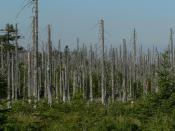Acid rain has been around for several centuries, but is causing more destruction throughout our environment now than ever before. Acid rain is produced by the releases of Sulphur Dioxide (SO2) and Nitrogen Oxides (NOx). These two gases once realised into the atmosphere combine and react with water, oxygen and oxidant compounds in the atmosphere. The reaction can take hours or even days, during which the polluted air can travel far from the original source of pollution. The mixture of these gases creates a mild solution of pH 5.6 or less, and then falls to the earth in rain, snow, fog or even as dry forms such as gas and particles.
90% of Sulphur dioxide and Nitrogen oxides are pumped into the air through human activity. Factories and power stations are highly responsible for polluting, but transport also has a huge impact from the petrol and diesel used, produced from crude oil.
Nitrogen oxides are also given out through natural processes such as volcano activities, fires, lightening and bacteria action in soils.
Acid rain is a worldwide problem. The effects of acid rain on the environment are huge. Wherever the slightly acidic solution falls, it can have a serious impact on humans, animals, even buildings and trees.
Acid rain can harm and even kills natural vegetation and crops. The roots are damaged by the acid, slowing the growth of plants, or even killing them. Soil is also destroyed, as the nutrients in the soil decay, leaving fewer nutrients available for plants. Also, when acid rain falls on plants with waxy leaves, it damages and leaves the plant vulnerable for diseases.
Acid rain and toxic chemicals also run or fall directly into lakes and streams making the acidity of the lakes increase - making the water too acidic for...


